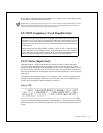
Regulatory Notices C-1
APPENDIX C
Regulatory Notices
Electromagnetic Interference (EMI) is any signal or emission, radiated in free space or conducted
along power or signal leads, that endangers the functioning of a radio navigation or other safety ser-
vice or seriously degrades, obstructs, or repeatedly interrupts a licensed radio communications
service. Radio communications services include but are not limited to AM/FM commercial broad-
cast, television, cellular services, radar, air-traffic control, pager, and Personal Communication
Services (PCS). These licensed services, along with unintentional radiators such as digital devices,
including computer systems, contribute to the electromagnetic environment.
Electromagnetic Compatibility (EMC) is the ability of items of electronic equipment to function
properly together in the electronic environment. While this computer system has been designed and
determined to be compliant with regulatory agency limits for EMI, there is no guarantee that inter-
ference will not occur in a particular installation. If this equipment does cause interference with
radio communications services, which can be determined by turning the equipment off and on, you
are encouraged to try to correct the interference by one or more of the following measures:
•
Reorient the receiving antenna.
•
Relocate the computer with respect to the receiver.
•
Move the computer away from the receiver.
•
Plug the computer into a different outlet so that the computer and the receiver are on different
branch circuits.
If necessary, consult a Technical Support representative of Dell Computer Corporation or an experi-
enced radio/television technician for additional suggestions. You may find the
FCC Interference
Handbook, 1986
, to be helpful. It is available from the U.S. Government Printing Office, Washing-
ton, DC 20402, Stock No. 004-000-00450-7 or on the World Wide Web at
http://www.fcc.gov/
Bureaus/Compliance/WWW/tvibook.html
.
Dell computer systems are designed, tested, and classified for their intended electromagnetic envi-
ronment. These electromagnetic environment classifications generally refer to the following
harmonized definitions:
•
Class A is typically for business or industrial environments.
•
Class B is typically for residential environments.
Information Technology Equipment (ITE), including peripherals, expansion cards, printers, input/
output (I/O) devices, monitors, and so on, that are integrated into or connected to the system should
match the electromagnetic environment classification of the computer system.


















